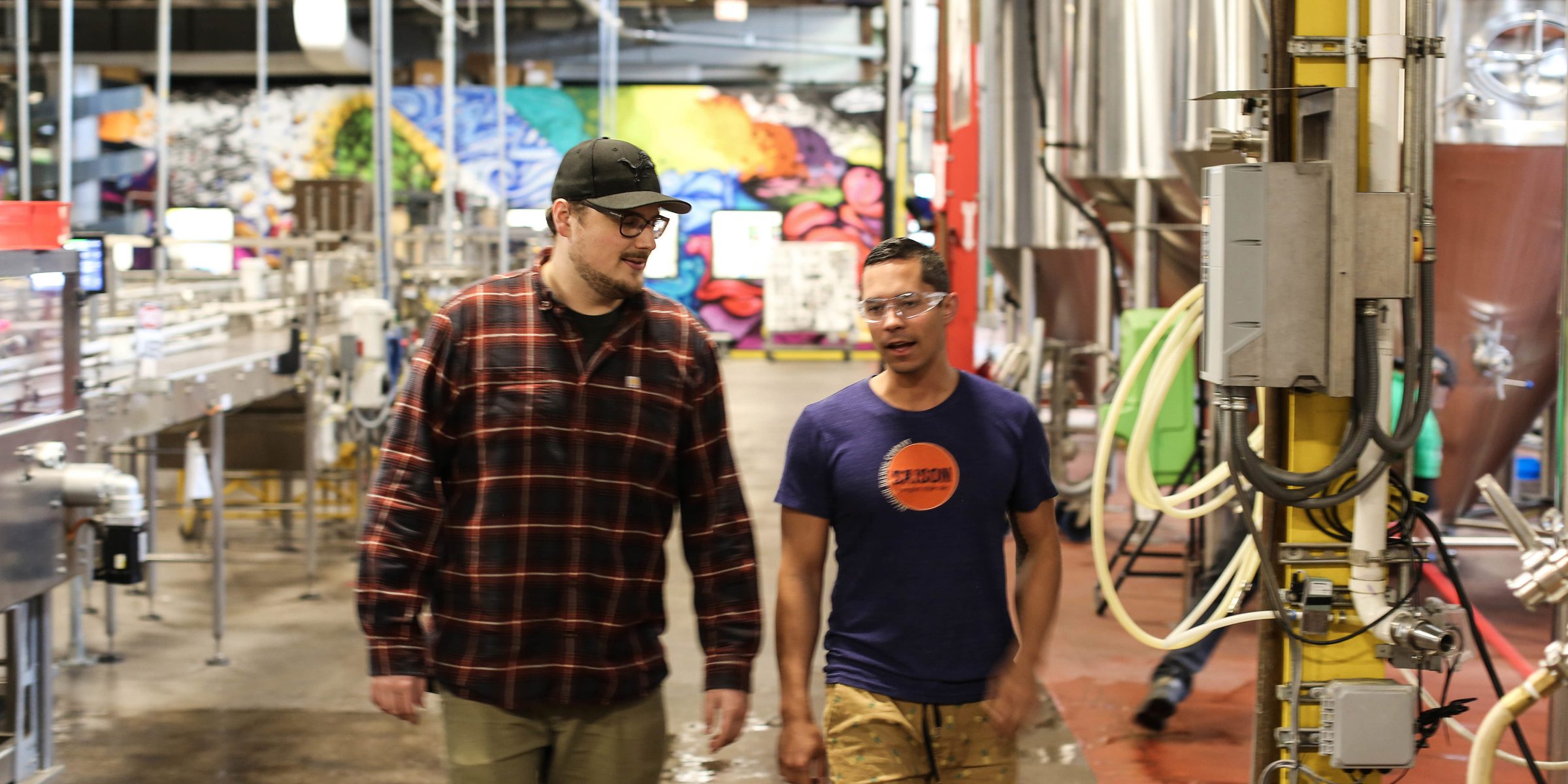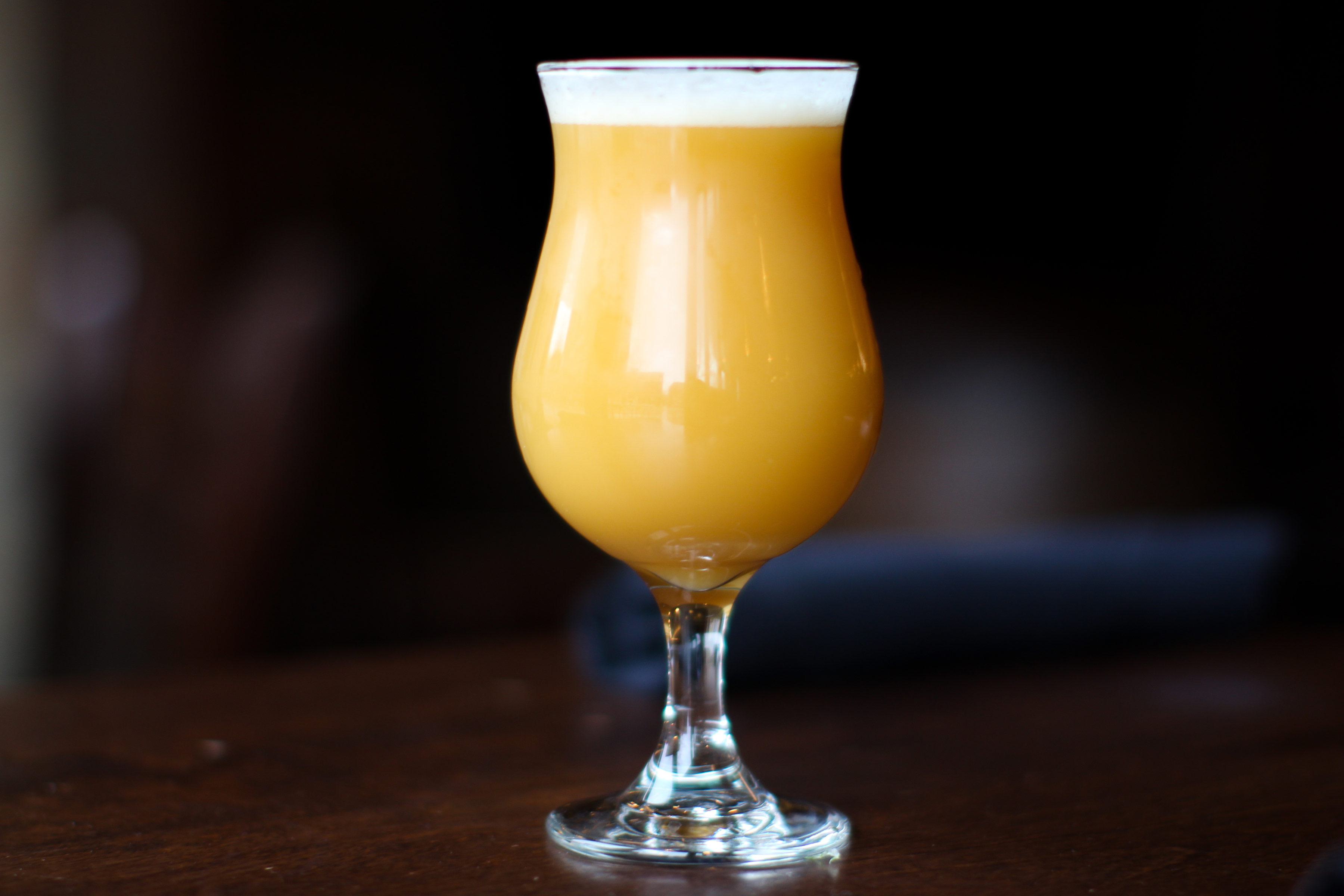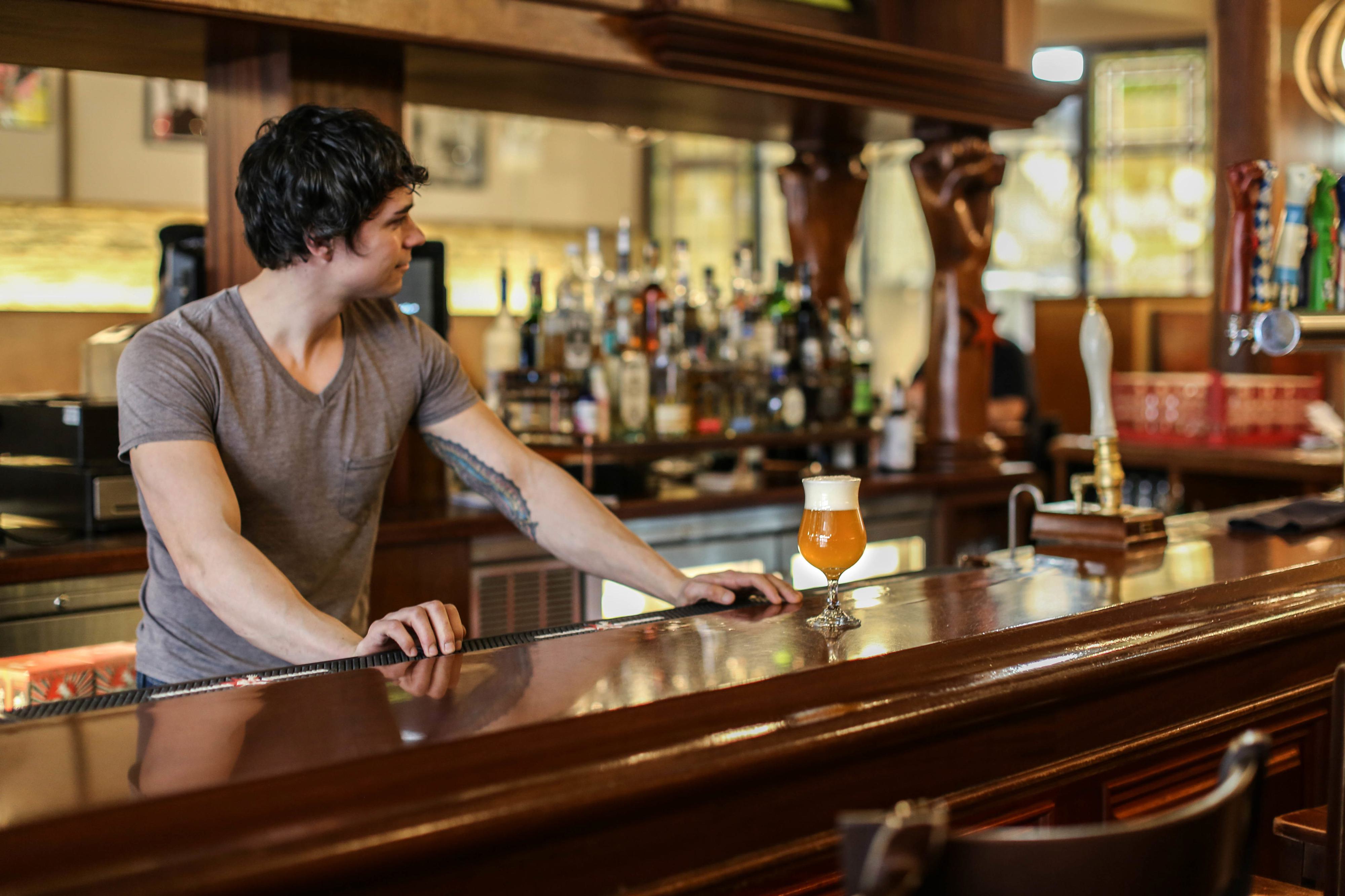
Working Through the Haze
The birth of Northeast-Hero
1) FRUIT-FORWARD FLAVORS FROM AN AGGRESSIVE DRY-HOPPING, WITH VERY LOW BITTERNESS

2) AN OPAQUE APPEARANCE - “JUICY” IN LOOK, AS WELL AS IN FLAVOR

3) THICKER BODY THAN TRADITIONAL IPAS AND A SMOOTH MOUTHFEEL
Brewers always like to see how they can put their own signature on classic styles, but it’s not as often that they get to explore an entirely new one. So when it came time for us to introduce a Hazy IPA to the Revolution lineup, we went to our original home and the place we’ve always looked to for innovation over the years –- the Revolution Brewpub.
LET’S MAKE A PUB HAZY
Our first official stab at a Hazy IPA started in February, with Jumpy Juice. We decided early on that we’d use the Pub batches to map out the style, see what we liked in the finished product, and change up the recipe each time. Since our Pub Brewer, John Palos aka “Jumpy”, would be the one creating these batches, we decided to name the beer after him. Most importantly, since we were creating this beer with the idea of eventually scaling up to production and distribution, our Brewery Manager Glenn Allen worked closely with Jumpy on choosing the malt, hops, yeast, and recipe techniques in each batch. Glenn needed information he could take back and apply at the production brewery, where he works with the beers that go into cans and out to wide distribution.
Despite the less-than-charitable view of Hazy IPAs that some people take, all versions are definitely not the same. So we had a lot to experiment on – the yeast (the backbone of hazies, for the fruity esters thrown off during fermentation, as well as appearance), the malt bill (for haze and body), the hops (not just the type and amount, but the combinations, timing, and presence in the finished product), the water chemistry (essential for the right finish), and more. For the first batch of Jumpy Juice, we triple-dry hopped with six pounds per barrel of Mosaic, Amarillo, and El Dorado, as well as some cryo-hop versions of each. We used a 40% oat mash for haze, and a silky mouthfeel. We picked an industry-favorite Vermont Ale Yeast, and just the smallest addition of bittering hops in the kettle.
The first batch was an interesting learning experience, but more importantly, it was delicious -- all stonefruit, melon, and peach bellini notes. The fruity aromas and juicy flavor practically leapt out of the glass. Its first week on tap at the Pub, it sold more than double the amount of our next-best-selling beer.
This, we thought, is what beer enthusiasts line up for. But we did have one thing to improve upon – it wasn’t especially hazy.

Why do you call him “Jumpy”?
When he originally came to Revolution, he was working on our Packaging team at the production brewery. He wasn’t the only John there, so he became John P. The packaging line is also fairly loud, so he had people calling out “John P.” to get his attention. Eventually, that morphed into Jumpy, and as everyone who went to summer camp, college, or the armed forces knows, if you yell a nickname at someone long enough, it’ll probably stick. And it did.
Getting to the Haze
The second batch is where the recipe tweaks made it clear how much room there is to experiment with the style. Jumpy Juice volume 2 looked nothing like the first go-round. This time, we added wheat to the malt bill, along with the oats, to get the level of haze that we didn’t achieve the first time. The bitterness was dialed even further down, and the double dry hop featured Mosaic, Citra, Nugget, and Pacifica hops.
It was another successful trial, with this one getting more acclaim from our fans for its fruit-forward hop character. The interesting part about that: the actual quantity of hops in the dry hop stage was significantly lower than the first Jumpy Juice.
“THE HAZE ITSELF IS RICH IN HOP PARTICLES, BETA ACIDS, AND MORE MATERIALS THAT GIVE THESE BEERS THEIR CHARACTERISTIC FRUIT FLAVORS. WITHOUT THE HAZE, YOU DON’T GET THOSE FLAVOR AND AROMA COMPOUNDS,” PALOS SAID. “HAZY GOES AGAINST EVERYTHING A LOT OF BREWERS WERE TAUGHT, BUT IT’S A KEY PART OF THE STYLE.”
Scaling Things Up
After two batches of Jumpy Juice, Glenn took the torch back to Kedzie for our first Hazy IPA trial with Revolution Brewmaster Jim Cibak and the rest of the brew team. Creating something at the Brewpub scale is much different than creating a beer in our production brewhouse for canning and distribution.
“Our job was to adjust a very small production beer, of a style that has really variable results, to a much bigger size, and maintain Revolution levels of quality,” Allen said.
Scaling up a Hazy Beer
- Create a stable haze. We wanted to make sure that whether it’s someone buying a six-pack at the brewery or someone cracking open a can and pouring into a glass gets an identical experience – no shaking/stirring/rolling required. “We send beer to a lot of places. We didn’t want to ship a beer that would end up crashing out in someone’s fridge,” Allen said.
- Keep them coming back. Big, fruity beers bring the craft fans out, but when we put something into six-packs, we want to make sure someone is coming back for the other 5. Without the usual balancing bitterness, we still wanted to build a very balanced beer that you’d want to (eventually) drink six of.
- Nail the hops at production level. Once you scale up, the option of brewing a hazy IPA at six or seven pounds of hops per barrel disappears. Glenn and team needed to get huge fruit-forward hop flavor at a production level using the right hops in the right proportions.

Biotransformation is a biological process (one terpenoid changing to another) that brewers can use to create new flavors from hops – especially the fruit-forward, tropical notes that have made the style so popular. The key here is using a yeast strain capable of this biotransformation – most of them aren’t, including our house ale yeast. That’s why the Jumpy Juice experiments were so key to building our understanding of the style.
Not long after Jumpy Juice II, we had our trial Hazy IPA at the production brewery complete. The Vermont yeast was replaced by a version of the popular London III yeast. Chinook and Centennial hops are added early to encourage biotransformation activity. Two different dry hop additions, including Citra, Cashmere, Galaxy, and Mosaic, pushed big pineapple and papaya flavors to the front. And thanks to the magic of water chemistry, the brewers engineered a finish crisp enough to stave off the sticky, fatigued palate drinkers can get from sweeter beers.
Back to the Pub and Introducing Northeast-Hero
For the third go-round, Jumpy celebrated with a tremendous 7+ pounds of Citra and Mosaic hops per barrel. He also swapped out the Vermont yeast for a traditional English yeast, and added both more wheat and Scottish Golden Promise malt for a honey-like backbone. Blood orange, honeydew and mango flavors absolutely abound. It looks the part of a Hazy, and it’s got all the hops you’d want short of a hop cone garnish.

LOOK FOR JUMPY JUICE VOLUME 4 THIS JULY, ON DRAFT AT THE BREWPUB AND THE TAPROOM.
Meanwhile, after trying plenty of Hazy IPAs from all across the country, putting different yeasts, hops, malts, through their paces at the Pub, and applying those lessons to a production-level beer, we’re ready to hit the market with our first canned Hazy IPA.


















